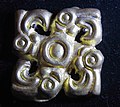51°11′48″N 52°10′37″E / 51.196575°N 52.176884°E
| Taksai kurgans | |
|---|---|
 Taksai-1 Golden Lady and artifacts. | |

| Saka kurgans[1] | ||||||||||||||||||||||||||||||
|---|---|---|---|---|---|---|---|---|---|---|---|---|---|---|---|---|---|---|---|---|---|---|---|---|---|---|---|---|---|---|
|
||||||||||||||||||||||||||||||
The Taksai kurgans (more precisely Taksai-1, Ru: Таксайский курган) are a series of Saka[2][3] or Sauromatian[4][5][6] funeral mounds or kurgans, located in the Terekti District of the southern Urals, in northwestern Kazakhstan.[7] They are dated to circa 500 BCE.[7] The Kurgan was undisturbed and had provided numerous valuable artifacts.[7][8] The Taksai-1 kurgan was the tomb of a rich Saka lady, dubbed the "golden lady".[7] Some of her objects reflect the iconography of the Achaemenid Empire, which must have been in contact with these nomadic tribes.[7]
The nomadic people of the southern Ural are traditionally identified as Sauromatians, but the people of the Taksai kurgan seem to be issued from the immigration of a new wave of nomads to the region around the 6th century BCE, who were characterized by this type of kurgans, and may represent the immigration of Asian nomads to the Urals, possibly prompted by the conflicts with the Achaemenid Empire.[4]
-
Taksai plan of barrow no. 6, burial ground Taksay-1; 2 – central pit covered by logs;3 – grave no. 3.
-
Taksai-1, barrow 6 artifacts
-
Taksai-1 Barrow 6 lady (reconstruction)
-
Pendant, Taksai I kurgan 6, 6-5th century BCE.[9]
-
Gold appliqués in the form of a ram’s head, Barrow 6 of Taksai I, Kazakhstan
-
Decoration of the tip of the hat. Taksai I, kurgan 6, 5th–4th century BCE. H. 46.0 cm. National Museum of the Republic of Kazakhstan
-
Small sewed-on plaque in the form of a swastika, formed from four heads of griffins. Taksai I, mound 6
-
Taksai artifacts
- ^ Image file with complete data, Amir, Saltanat; Roberts, Rebecca C. (2023). "The Saka 'Animal Style' in Context: Material, Technology, Form and Use". Arts. 12: 23. doi:10.3390/arts12010023.
- ^ Times, Astana (27 September 2019). "Kazakh National Museum to present masterpieces of ancient and medieval art in Kuala Lumpur". The Astana Times.
the Saka mounds of Taksai in the West Kazakhstan Region
- ^ Kang, In Uk (2020). "Archaeological Perspectives on the Early Relations of the Korean Peninsula with the Eurasian Steppe" (PDF). Sino-Platonic Papers. 301: 7.
The Tasmola Culture of the early Scythia Culture is spread across Central Kazakhstan, while the Savromat and Sarmat cultures are distributed along Western Kazakhstan and the Ural Mountain regions. The Taksai kurgan of Western Kazakhstan and the Pokrovka kurgan of the Ural Mountains are the distinctive archaeological remains found in those regions. Represented by these, Saka Culture refers to the groups of people who built great burial mounds and created gold relics based on the nomadic economy of Central Asia centered in Kazakhstan.
- ^ a b Summerer 2020, p. 604, notes 82, 85: "The southern Ural piedmont is traditionally associated with the Sauromatians, a collective ethnonym used for all nomadic people living in the vast region east of the Don at the time of Herodotus. However, recent studies see the inhabitants of this region as multi-ethnic and favour the more neutral term of early nomads of the southern Ural piedmont. While the Bronze Age in the southern Ural region is archaeologically well evidenced, there seems to be a hiatus in the first half of the 1st millennium BC. It has been suggested that new nomad groups came into the region during the 6th century BC. The earliest archaeological evidence of this immigration is a group of kurgan burials of the late 6th or early 5th century BC, of which Taksai-1 is part."
- ^ Lukpanova, Ya.A. (2017). "Reconstruction of Female Costume From the Elite Burial Ground Taksay-I: a View of the Archaeology". Povolzhskaya Arkheologiya (The Volga River Region Arcaheology). 1 (19).
- ^ Gursoy, M. (28 February 2023). "Жазба Және Археологиялық Деректер Негізінде Савромат-Сармат Тайпаларының Шығу Тегі". BULLETIN Series Historical and Socio-political Sciences. 1 (72): 159. doi:10.51889/2022-1.1728-5461.16.
In particular, B. N. Grakov proposed a general four-stage chronology of the Savromat-Sarmatian tribes, based on the specifics of their burial structures, burial traditions and material world: 1.The Savromat period or Blumenfeld -VI-IV centuries BC. 2.Savromat-Sarmatian or Prokhorov period-IV-II Centuries BC. 3.The middle Sarmatian period or Suslov -II BC -II Centuries AD. 4.The late Sarmatian period or Shipov –II –IV centuries AD. Since this proposal is generally supported by the majority, this chronology is taken as a basis in the research papers.
- ^ a b c d e Summerer 2020.
- ^ Lukpanova, Yana Amangeldyevna (30 November 2018). "A complex of ritual objects from the elite female burial in Western Kazakhstan". Samara Journal of Science. 7 (4): 228–232. doi:10.17816/snv201874211.
- ^ Pankova, Svetlana; Simpson, St John (1 January 2017). Scythians: warriors of ancient Siberia. p. 137, item 67.





![Pendant, Taksai I kurgan 6, 6-5th century BCE.[9]](http://upload.wikimedia.org/wikipedia/commons/thumb/5/57/Saka_jewelry.jpg/79px-Saka_jewelry.jpg)



